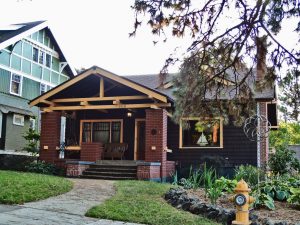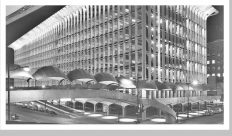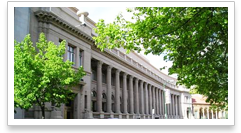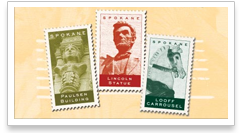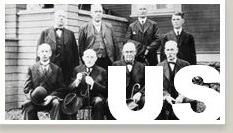What is the Cannon Streetcar Suburb Local Historic District?
This is a collaborative project between the City of Spokane Historic Preservation Office and the Cliff-Cannon Neighborhood Council to list the Cannon Streetcar Suburb Historic District in the Spokane Register of Historic Places with grant funding from the Department of Archaeology and Historic Preservation. A local register listing allows property owners to take advantage of certain incentives (see below) as well as protects the historic character of the area that is under the overlay zone created through ordinance.
What is the Spokane Register of Historic Places?
The Spokane Register of Historic Places is the City’s official list of properties that have been designated as significant contributors to the historical development of Spokane. The Register was established by ordinance in both the City and County of Spokane in 1981 and 1982, respectively. These ordinances deem the City/County Historic Landmarks Commission responsible for the stewardship of historic and architecturally significant properties. Nominations to the Spokane Register must be accompanied by owner consent.
Aren’t parts of the Cliff-Cannon Neighborhood already part of historic districts?
Yes, there are two small (four properties each) Spokane Register Historic Districts (Booge’s Addition and Comstock-Shadle) as well as two much larger National Register Historic Districts (9th Avenue Historic District and the Marycliff-Cliff Park Historic District) within the Cliff-Cannon Neighborhood’s boundaries. The National Register designation is an honorary listing, whereas listing on the Spokane Register of Historic Places allows for review of exterior changes by the Historic Preservation Office and/or the Spokane Historic Landmarks Commission. Listing in the Spokane Register also makes buildings that are considered historic in the district eligible for Special Tax Valuation, a property tax reduction program.
What is Special Valuation?
Special Tax Valuation is an incentive program to reward folks who invest in their historic properties. In a nutshell, the Assessor’s office reduces the assessed value of an historic property by the amount spent on a rehabilitation for ten years. Properties must be listed on the Spokane Register of Historic Places (or “contributing” in an historic district) prior to application to qualify. The Spokane Historic Landmarks Commission will review the work that was done on the property. In order to qualify, rehabilitation costs must total 25% or more of the assessed valued of the structure (not the land) prior to rehabilitation.
What is an historic district?
An historic district is a group of any number of inter-related historic resources (these can include buildings, structures, sites, and objects) that share an association(s) with significant historical events and/or patterns of history on a local, regional, and/or national level. For the Cannon Streetcar Suburb Historic District, these associations are with the development of the City of Spokane in the late-1800s through the early- and mid-1900s; significant events include the early development of the City – especially as it relates to the transportation innovations of early Spokane, as well as associations with housing war veterans. The proposed district also has many buildings that are significant for their architecture.
So, will everything in the historic district be significant?
Not necessarily. The historic district will have defined boundaries and what we call a “period(s) of significance.” What is a period of significance? It refers to the span of time during which significant events and activities occurred. Events and associations with historic properties are finite; most properties have a clearly definable period of significance. For the Cannon Streetcar Suburb Historic District – the period of significance starts when the first extant building was constructed and ends in 1955 when development of new housing slowed considerably. These definitions will inform which buildings will contribute to the historic district, and which do not.
What does “contributing” and “non-contributing” mean?
A contributing building in the Cannon Streetcar Suburb Historic District will have to meet all of the following criteria:
- Located within the defined boundary
- Constructed during the period of significance
- Have at least some of its exterior historic architectural elements (we will look at windows, porches, siding and plan to determine how much change has occurred to the building over time)
A building in the historic district would not contribute if it does not meet all of the above criteria. For example, a building could be within the boundary and constructed within the period of significance, but it has been altered so much that it does not look like it was constructed during the period of significance. Another example would be if is within the boundary and has not been altered, but was constructed after the period of significance.
How will the historic district be listed in the Spokane Register?
In order for any historic district to be listed in the Spokane Register, the district needs a majority (50%+1) of “yes” votes from property owners of tax parcels within the boundary of the historic district. If achieved, the nomination will then be brought in front of the Spokane City Council for a vote, along with design standards and guidelines that are specific to the neighborhood. It will then be up to the City Council to create an overlay zone which will list the historic district and enact the design standards and guidelines.
What are design standards and guidelines?
Design Standards and Guidelines for the Cannon Streetcar Suburb Historic District will be written and prepared in tandem with the historic district nomination to assist historic district property owners, City staff and Spokane Historic Landmarks Commission (SHLC) members regarding appropriate design for the rehabilitation of existing buildings and new construction in the Historic District. The design standards will consider the existing character of the neighborhood and anticipate future changes. The goal of the design standards is to provide clear direction and guidance for bridging the existing character and future/envisioned changes. The standards will be designed to encourage high-quality urban spaces defined by a variety of building types, streetscapes, signage, public spaces, building elements, and other important architectural characteristics of this diverse neighborhood. As an example, here are the Design Standards and Guidelines developed for the Browne’s Addition Historic District – the Cannon Streetcar Suburb Historic District Standards and Guidelines will be similar, but tailored specifically for the district.
How is the 50%+1 majority determined: by total property owners regardless of response, or, as is done with electoral votes, by the total of votes received?
The 50%+1 will be of the total of property owners within the proposed boundary of the historic district. Any lack of response from a property owner will be considered a “no.” Each developable tax parcel will get one vote. If someone owns several tax lots, they get that many votes. For example, if you own 3 developable tax parcels within the proposed boundary of the historic district, you will get three votes. If you do not respond, it will be considered 3 “no” votes.
Are there volunteer opportunities?
Absolutely! The Cannon Streetcar Suburb Historic District always use your help spreading the word about the project and informing property owners about the voting process. A neighborhood team has been assembled to help spread the word about workshops, voting, etc. If you are interested in helping, please contact Logan Camporeale, Historic Preservation Specialist at the City’s Historic Preservation Office: lcamporeale@spokanecity.org.
